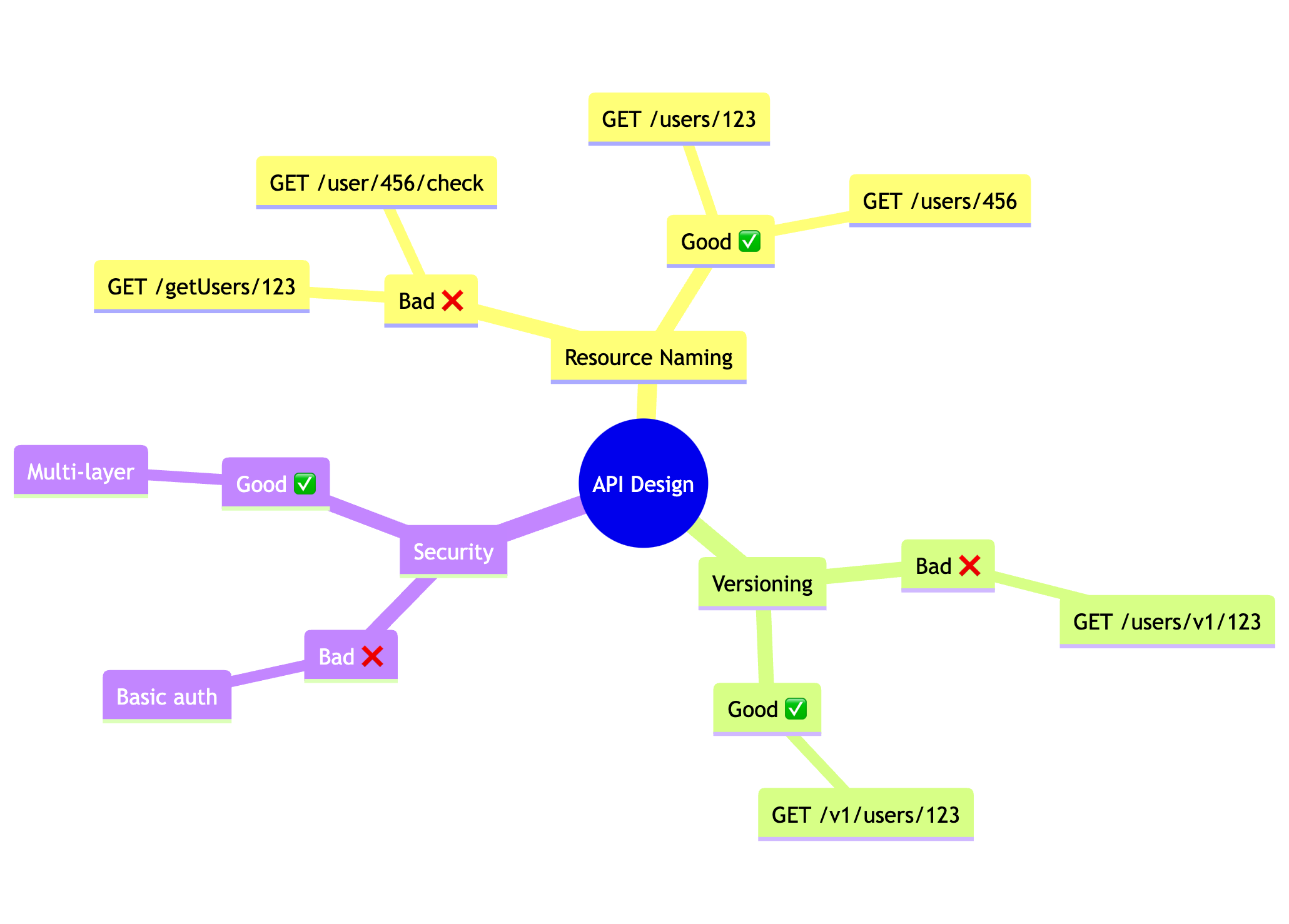Why Your API Endpoints Keep Breaking?
Learn why APIs break and how to fix them with practical patterns for naming, security, error handling, and performance.

Building stable APIs is more than following REST conventions—it's about designing endpoints that remain reliable under actual production loads. Whether you're handling user authentication, processing payments, or managing content, unstable APIs can lead to cascading failures, frustrated clients, and lost business opportunities.
| Pattern | ❌ Incorrect | ✅ Correct |
|---|---|---|
| Resource Naming | GET /getUsers/123 | GET /users/123 |
| Response Format | { "users": [...] } [...] |
{ "success": true, "data": {...}, "error": null } |
| Error Handling | HTTP 500 for all errors | { "success": false, "error": { "code": "VALIDATION_ERROR", "message": "Invalid input" }} |
| Versioning | GET /users/v1/123 | GET /v1/users/123 |
| Pagination | GET /users | GET /users?page=1&limit=10 |
| Security | X-API-KEY=xxx | X-API-KEY=xxx X-REQUEST-SIGNATURE=hmac(...) |
| Idempotency | POST /orders | POST /orders Idempotency-Key: uuid-123 |
| Rate Limiting | No rate limit | X-RateLimit-Limit: 100 X-RateLimit-Remaining: 95 |
The Problem
Every developer has experienced these scenarios:
- Production alerts flooding in at 3 AM
- Clients reporting intermittent API failures
- Duplicate transactions appearing mysteriously
- New API versions breaking existing integrations
- Endpoints crashing under unexpected load
Let's explore common patterns that cause APIs to break and provide battle-tested solutions using practical examples.
1. Resource Naming Consistency
The Problem
Imagine joining a project where different teams have built various API endpoints:
GET /getUsers/123
GET /user/456/check
GET /users/789
This inconsistency creates:
- Confusion among API consumers
- Increased documentation overhead
- Difficulty in maintaining API clients
- Challenges in API evolution
The Solution
Implement a consistent resource naming strategy:
- Use Plural Nouns for Collections
# ✅ Good
GET /users/123
GET /orders/456
GET /products/789
# ❌ Bad
GET /user/123
GET /getOrder/456
GET /manage-product/789
- Maintain Clear Resource Hierarchy
# ✅ Good
GET /users/123/orders
POST /orders/123/items
# ❌ Bad
GET /userOrders/123
POST /addItemToOrder/123
2. Request/Response Structure
The Problem
Inconsistent data structures lead to:
- Difficult client integration
- Unpredictable error handling
- Poor developer experience
- Increased maintenance overhead
The Solution
- Standardized Response Format
from typing import TypeVar, Generic, Optional
T = TypeVar('T')
class APIResponse(Generic[T]):
def __init__(
self,
success: bool,
data: Optional[T] = None,
error: Optional[dict] = None
):
self.success = success
self.data = data
self.error = error
@app.get("/users/{user_id}")
async def get_user(user_id: str):
try:
user = await User.get(user_id)
return APIResponse(
success=True,
data=user.dict()
)
except Exception as e:
return APIResponse(
success=False,
error={
"code": "USER_NOT_FOUND",
"message": str(e)
}
)
- Pagination Implementation
from fastapi import Query
@app.get("/users")
async def get_users(
page: int = Query(1, gt=0),
limit: int = Query(10, le=100)
):
users = await User.paginate(page, limit)
return APIResponse(
success=True,
data={
"items": users,
"pagination": {
"page": page,
"limit": limit,
"total": await User.count()
}
}
)
3. Error Handling
The Problem
Poor error handling leads to:
- Confused clients
- Difficult debugging
- Security vulnerabilities
- Inconsistent error responses
The Solution
- Standardized Error Structure
from enum import Enum
from fastapi import HTTPException
class ErrorCode(Enum):
VALIDATION_ERROR = "VALIDATION_ERROR"
NOT_FOUND = "NOT_FOUND"
UNAUTHORIZED = "UNAUTHORIZED"
INTERNAL_ERROR = "INTERNAL_ERROR"
class APIError(Exception):
def __init__(
self,
code: ErrorCode,
message: str,
status_code: int = 400
):
self.code = code
self.message = message
self.status_code = status_code
@app.exception_handler(APIError)
async def api_error_handler(request, exc: APIError):
return JSONResponse(
status_code=exc.status_code,
content={
"success": False,
"error": {
"code": exc.code.value,
"message": exc.message
}
}
)
- HTTP Status Code Usage
@app.get("/users/{user_id}")
async def get_user(user_id: str):
user = await User.get(user_id)
if not user:
raise APIError(
code=ErrorCode.NOT_FOUND,
message="User not found",
status_code=404
)
return APIResponse(success=True, data=user)
4. Security Implementation
The Problem
Inadequate security measures lead to:
- Data breaches
- Unauthorized access
- API abuse
- Compliance issues
The Solution
- Authentication Middleware
from fastapi import Security, Depends
from fastapi.security import APIKeyHeader
api_key_header = APIKeyHeader(name="X-API-Key")
async def verify_api_key(api_key: str = Depends(api_key_header)):
if not is_valid_api_key(api_key):
raise APIError(
code=ErrorCode.UNAUTHORIZED,
message="Invalid API key",
status_code=401
)
return api_key
@app.get("/secure-endpoint")
async def secure_endpoint(api_key: str = Depends(verify_api_key)):
return {"message": "Secure data"}
- Request Signing
import hmac
import hashlib
import time
class RequestSigner:
def __init__(self, secret_key: str):
self.secret_key = secret_key
def sign_request(self, payload: str, timestamp: str) -> str:
message = f"{payload}{timestamp}"
return hmac.new(
self.secret_key.encode(),
message.encode(),
hashlib.sha256
).hexdigest()
5. Performance Optimization
The Problem
Unoptimized APIs can lead to:
- Slow response times
- High server costs
- Poor user experience
- System overload
The Solution
- Caching Implementation
from fastapi_cache import FastAPICache
from fastapi_cache.decorator import cache
@app.get("/products")
@cache(expire=300) # Cache for 5 minutes
async def get_products():
products = await Product.all()
return APIResponse(success=True, data=products)
- Bulk Operations
@app.post("/users/bulk")
async def create_users(users: List[UserCreate]):
async with async_session() as session:
created_users = await User.bulk_create(users)
return APIResponse(
success=True,
data=created_users
)
- Query Optimization
from sqlalchemy import select
from sqlalchemy.orm import joinedload
async def get_user_with_orders(user_id: str):
query = select(User).options(
joinedload(User.orders)
).where(User.id == user_id)
return await session.execute(query)

Conclusion
Building stable APIs requires:
- Consistent resource naming
- Standardized request/response formats
- Robust error handling
- Strong security measures
- Performance optimization
Remember: The best APIs are those that remain stable, secure, and performant under production environments conditions.
FAQs
How do I handle long-running operations in my API?
- Use asynchronous patterns
- Return 202 Accepted with operation ID
- Provide status endpoint
What's the best way to handle authentication/authorization?
- Use JWT for stateless auth
- Implement role-based access
- Add request signing for sensitive operations
- Use short-lived tokens
